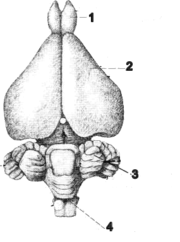Olfactory bulb
|
|
The olfactory bulb is a part of the brain that is a distinct outgrowth from the forebrain of mammals. As one might guess from the name, it plays a major role in olfaction, which is the perception of smells. In terms of evolution, the olfactory bulb arises from a very old part of the brain. The olfactory bulb is supported and protected by the cribriform plate.
The olfactory bulb receives direct input from olfactory nerve, made up of the axons from approximately 10 million olfactory receptor neurons in the olfactory mucosa, a region of the nasal cavity. The ends of the axons cluster in spherical structures known as glomeruli (of which there are between 1000 and 2000), and each glomerulus receives input primarily from a single type of olfactory receptor neuron. Glomeruli are permeated by dendritic inputs to neurons known as mitral cells, which in turn output to the olfactory cortex. Glomeruli are surrounded by periglomerular cells. These cells probably have some role in negative feedback.
Mitral cells are connected by interneurons known as granule cells, which seem to produce a sort of lateral inhibition between mitral cells. It is not yet fully known what the functional role of this lateral inhibition is, though it may be involved in boosting the signal-to-noise ratio of odor signals by silencing the basal firing rate of surrounding non-activated neurons.
| Sensory system - Olfactory system | Edit (http://en.wikipedia.org/w/wiki.phtml?title=MediaWiki:Olfactory_system&action=edit) |
|
Olfactory bulb - Olfactory nerve - Olfactory epithelium - Glomeruli - Olfactory mucosa - Olfactory receptor neurons - Mitral cells - Piriform cortex |

